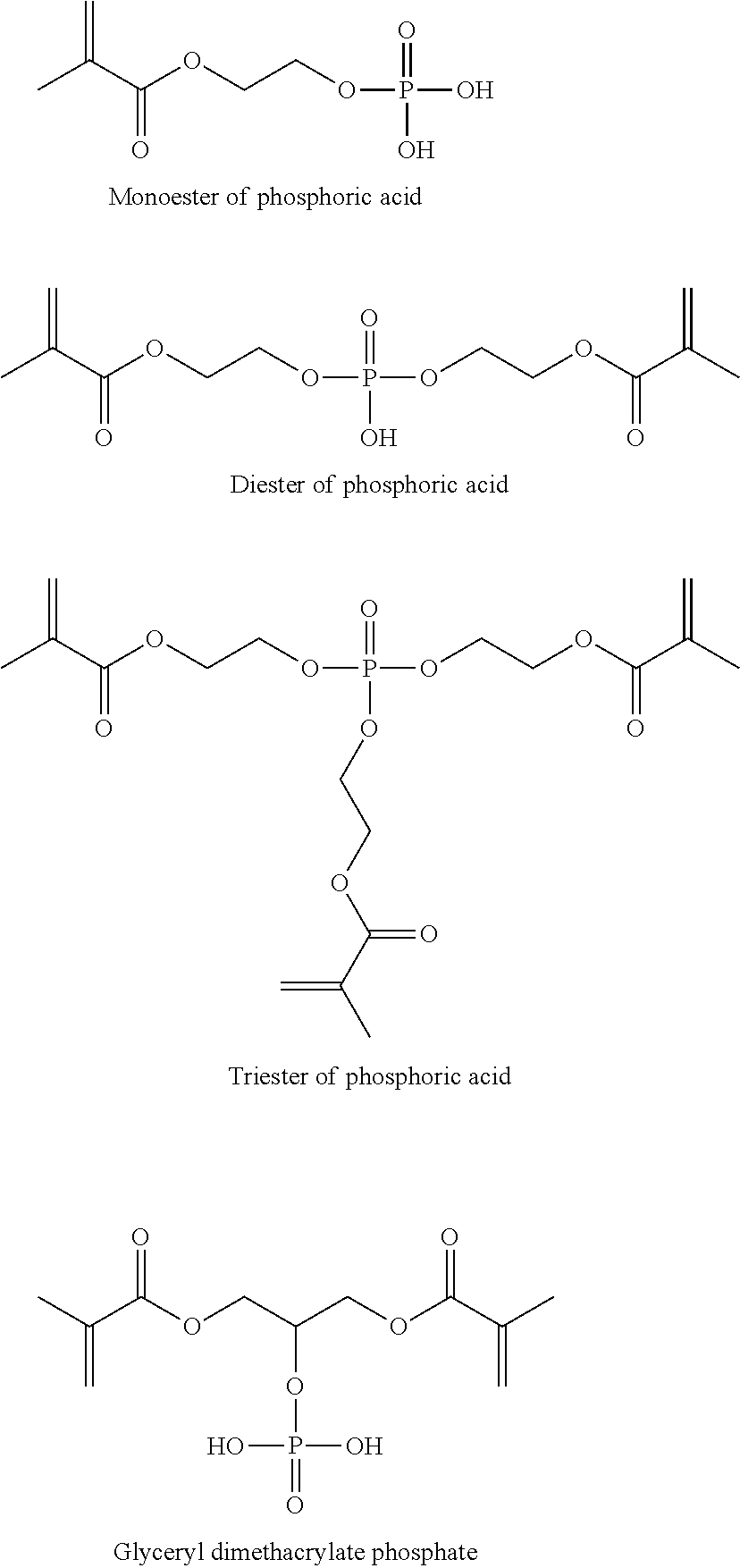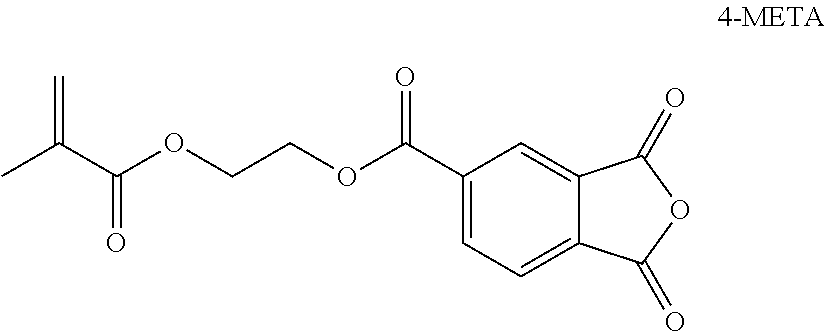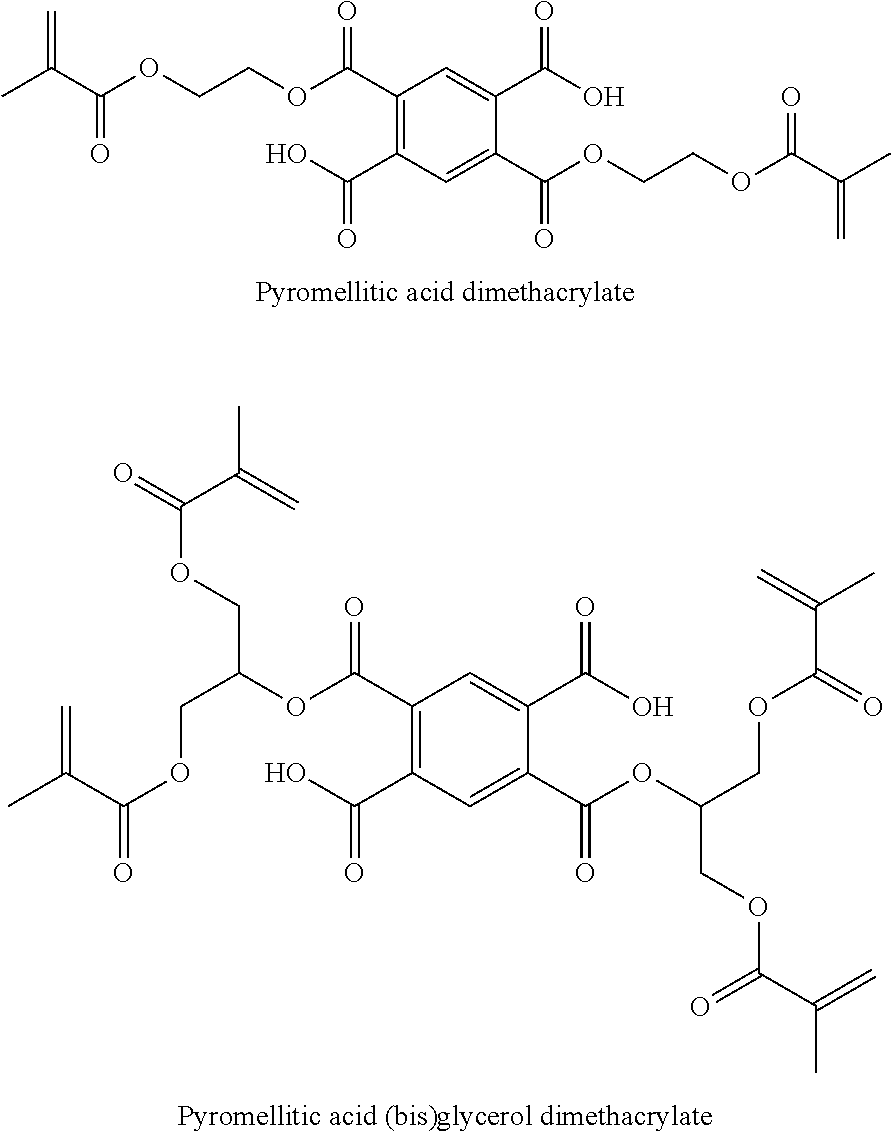Polymerizable phosphoric acid derivatives comprising a polyalicylic structure element
a polyalicylic structure element and polymerizable phosphoric acid technology, applied in the field of new polymerizable phosphoric acid derivatives, can solve the problems of amalgam being toxicologically dangerous, no longer meeting, and loss of fillings
- Summary
- Abstract
- Description
- Claims
- Application Information
AI Technical Summary
Benefits of technology
Problems solved by technology
Method used
Image
Examples
example 1
Synthesis of the Compound of Formula (1) (not According to the Invention)
[0313]3.80 g (19.36 mmol) of 3(4), 8(9)-bis(hydroxymethyl)tricyclo[5.2.1.02,6]decane were dissolved in 15 ml of tetrahydrofuran and 0.04 g of BHT and 0.105 g (approximately 0.1 mol. %) of the catalyst solution were added. Under agitation 3.00 g (19.34 mmol) of 2-isocyanatoethyl methacrylate dissolved in 10 ml of THF were dropped in. Once addition was complete the dropping funnel was replaced by a reflux condenser and the reaction mixture heated to 60° C. with the continuation of the reaction being monitored by IR spectroscopy. After 24 hours no further isocyanate bands could be detected. The solvent was removed using the rotary evaporator. The urethane of formula (1) was obtained in a yield of 6.66 g (18.95 mmol, corresponding to 98% of the theory).
example 2
Synthesis of the Compound of Formula (3)
[0314]2.56 g (16.69 mmol) of POCl3 were dissolved in 20 ml of methyl-tert-butyl ether and cooled to −78° C. Under vigorous agitation a mixture of 5.10 g (14.51 mmol) of the compound of Formula (1) from Example 1 and 1.69 g (16.69 mmol) of triethyl amine in 10 ml of methyl-tert-butylether were dropped in. Following this addition agitation was continued for an hour and the reaction mixture then had 0.91 g (50.79 mmol) of water and 3.67 g (36.28 mmol) of triethyl amine added at 0° C. Following agitation for a further hour at ambient temperature, the reaction mixture was recycled with 1% hydrochloric acid and then with water. The organic phase was dried over magnesium sulfate and the solvent then removed in the rotary evaporator. 3.85 g (8.90 mmol, corresponding to 61% of the theory) of compound (3) remained.
example 3
Synthesis of the Compound of Formula (7) (not According to the Invention)
[0315]3.80 g (19.36 mmol) of 3(4), 8(9)-bis(hydroxymethyl)tricyclo[5.2.1.02,6]decane and 1.70 ml (1.66 g, 21.0 mmol) pyridine were dissolved in 50 ml of chloroform and then under ice cooling 1.89 ml (2.02 g, 19.36 mmol) methacrylic acid chloride, dissolved in 10 ml of chloroform, were dropped in. Once addition was complete agitation took place overnight at ambient temperature. The next day, 150 ml of 1N hydrochloric acid were added to the reaction mixture which was then transferred to a separating funnel and the phases separated. Then shaking out with saturated NaHCO3— and NaCl solution took place followed by washing with water. The organic phase was dried over MgSO4 and the solvent removed following addition of 0.04 g BHT on the rotary evaporator. The methacrylic acid ester of formula (7) was obtained in a yield of 4.93 g (18.78 mmol, 97% of theoretical).
PUM
| Property | Measurement | Unit |
|---|---|---|
| structure | aaaaa | aaaaa |
| adhesion | aaaaa | aaaaa |
| corrosion | aaaaa | aaaaa |
Abstract
Description
Claims
Application Information
 Login to View More
Login to View More - R&D
- Intellectual Property
- Life Sciences
- Materials
- Tech Scout
- Unparalleled Data Quality
- Higher Quality Content
- 60% Fewer Hallucinations
Browse by: Latest US Patents, China's latest patents, Technical Efficacy Thesaurus, Application Domain, Technology Topic, Popular Technical Reports.
© 2025 PatSnap. All rights reserved.Legal|Privacy policy|Modern Slavery Act Transparency Statement|Sitemap|About US| Contact US: help@patsnap.com



